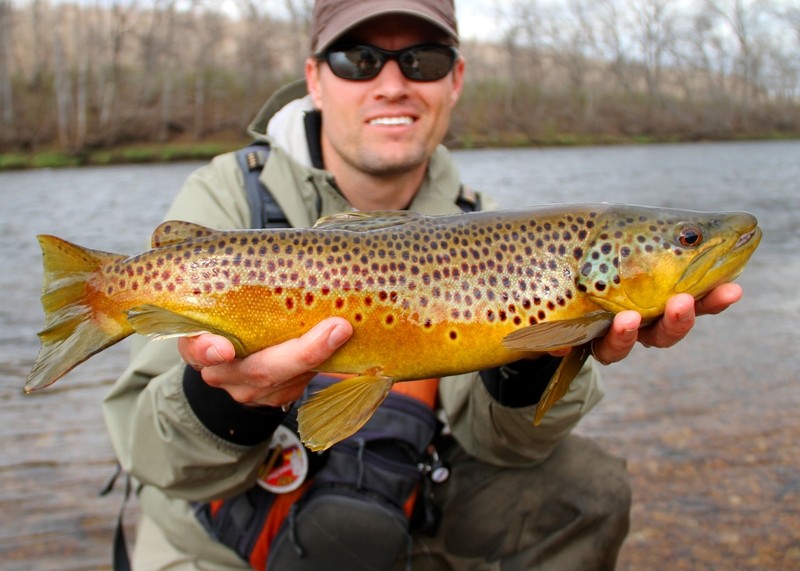Some fishing equipment is small. Hooks, for example, range in size. But since you won't be fishing for great while sharks, you can forget the big hooks and focus on the smaller ones. Those can EASILY fit into an empty pill container or an empty Altoids tin. So adding those and about 100 ft. of fishing line to your camping equipment will serve you well in an emergency.
1. Set Multiple Fishing Lines
One way to fish in an emergency is to tie a line with a baited hook, and attach it to a low lying branch over a stream, lake, or pond.
If you set 20 lines and hang each line from a different tree branch, you have a lot more chances of actually catching a fish. That would be like having 20 fishing poles going at once. Odds are one of these baited hooks is going to catch a fish.2. Fishing from Tree Branches
To avoid the hassle and time of pole fishing in cover, realize that an overhead tree branch can provide a great way to fish in cover, with a lot less chances of getting snagged. You don't need a fishing pole for this.Tie your line to a branch over the water, water that's a few feet deep, near cover (grass and weeds, fallen trees, etc), and let your baited hook settle in. Depending on the water's depth, set your line 5-6 feet from a swivel (a swivel allows a fishing line natural movement in the water), with a bullet weight or other weight tied above the swivel.
Tie as many as 20 or more of these along the shoreline, and now simply watch from the bank for any tree branches to start moving, signaling that you've caught a fish. Be ready to wait for a few hours, if that's what it takes to get a bite.
Not sure what a swivel is? Not sure what a leader or bullet-weight are? Don't know how to properly tie a hook? I encourage you to visit your nearest fishing supply store and get yourself a quick demo from one of the staff on hand and then simply practice your ties at home. It's not difficult to get this down.
3. Use Balloons
Carry a package of 100 or more white or gray colored balloons into the backcountry. In an emergency situation, these can be inflated and used as “floats”, when overhead branches aren't available, or you simply want to set more lines in cover.Tie a baited hook, along with a weight and swivel, and hang from each balloon. An inflated balloon has a wide surface area, and will float on top of the water. Your line and hook will hang vertically, and float amid the grasses and weeds, submerged logs, etc. When a fish bites, it won't be able to pull the balloon underwater. The balloon has too much buoyancy.
Be sure to run a second stretch of fishing line from the balloon to the shore, so that a large fish doesn't take off with it, once it's been hooked.As soon as a fish is on the hook, you'll know it — you'll see the balloon start moving on the water. Make your way to the balloon and pull up the line and you should have a fish on the end.
What if there's a current? Some lakes have a current that sometimes occurs in areas where lakes are fed or exited by rivers; sometimes high winds can move balloon floats also; try using more weight on your line to keep these balloons in place or simply tie a second tether (stretch of fishing line) to a balloon, and then run that line to the shore, where it can be tied and anchored.
4. Finding Natural Bait
Like live worms, the land around you provides an assortment of possible bait. Even in an urban environment. From Night crawlers, grubs, and maggots, to grasshoppers, ants, mayflies, midges, centipedes, millipedes, caterpillars, craw dads/crayfish, aquatic snails, and even bees and beetles. Again, just depends on where you're at and what it's possible to catch in the stream or lake you're fishing in.If one kind of natural bait isn't working, try another kind. Better yet, since this is an emergency and part of your strategy will be multiple fishing lines (illegal in many states, but again this is an emergency and your life is on the line), use multiple types of bait: Worms, maggots, bugs, craw dads, etc. Run 10 worms on 10 hooks and then run 10 crawling bugs on 10 other hooks and finally 10 flying bugs on 10 hooks also. Vary the height in the water (run short leaders, weighted to the bottom, to fish for bottom feeding fish; let others float atop the water for fish that feed on insects and other natural bait near the top.)
If you're counting hooks, that's 30 lines you'll have in the water with the chances to catch more than one species of fish. Do you understand now why this kind of fishing is illegal, outside of a true emergency?
5. Use Fish to Catch Fish
When you do catch a fish, set aside portions of that fish that you can use as bait. Several types of fish eat smaller fish, and will often bite your hook, if it has a portion of fish on the end.
Just to piggy back on #2 – If you are unable to get to a bait and tackle shop, that's ok. We live in the age of the internet, so a simple YouTube search will give you a large variety of How-To and Instructional videos that will help you become more efficient with your skills.
This great list of tips was provided by the helpful folks at Secrets of Survival.
